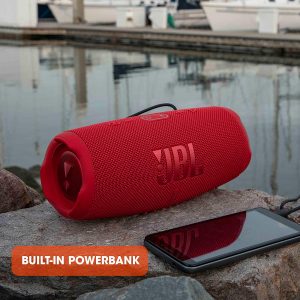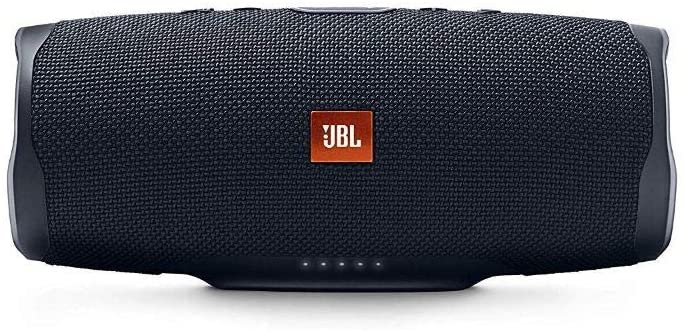|
Full power! JBL Charge 5
Dimensions: 22 x 9.6 x 9.3 cm |
Maximum experience! JBL Charge 4
Dimensions: 22 x 9.5 x 9.3 cm |
If something characterizes the JBL company, it is having a catalog of quality products at a good price. This practical philosophy has helped them to take the top positions in the market with various items, although they stand out above all their wireless speakers, which have become a benchmark.
In this sense, we want to put two models of wireless speakers against the ropes: the JBL Charge 5 and the JBL Charge 4, two magnificent speakers that stand out for their sound quality and autonomy.
By way of introduction, we’re going to pit the best-selling and user-acclaimed Charge 4 against the Charge 5, which is supposed to have come on the market to take its predecessor’s place. Has it met your expectations?
Do not miss this comparison to find out if the JBL Charge 5 has achieved its goal. Let’s get started!
JBL Charge 5 vs. Charge 4 – Comparison Table
As an appetizer, you can find the main characteristics of each model in this comparative table. Take a look and do not miss the subsequent analysis.
JBL Charge 5
|
JBL Charge 4
|
|
| Dimensions (centimeters) | 22 x 9.6 x 9.3 | 22 x 9.5 x 9.3 |
| Weight | 960 grams | 965 grams |
| Connectors | USB output. USB-C | USB output. Jack 3.5 auxiliary input. USB-C |
| Power | 30W Woofer – 10W Tweeter | 30W Woofer |
| frequency response | 60 Hz – 20k Hz | 60 Hz – 20k Hz |
| Battery | 20 hours | 20 hours |
| Loading time | 4 hours | 4 hours |
| Power Bank | Yes | Yes |
| Certificates | IP67 | IPX7 |
| Connection with other speakers | JBL PartyBoost | JBL Connect Plus |
| Bluetooth | 5.1 | 4.2 |
| Microphone | Not | Not |
| Hands free function | Not | Not |
Similar design

Broadly speaking, we could be talking about two identical models.
As we have seen in the table in the previous section, the dimensions of both models are practically the same, a statement that we could share in their weight.
From an aesthetic point of view we do find more differences. For example, regarding the JBL logo, in the Charge 4 it is present in a more classic, smaller way and with its peculiar reddish color with white letters. On the other hand, in the Charge 5 the brand name appears in a much larger size, although it maintains the same color as the rest of the speaker.
Another aesthetic detail is the LED light present in the lower part of the front of the speakers. They indicate the status of the battery. In the Charge 4 it does so by means of five dots that light up, while in the Charge 5 the indicator appears in the form of a vertical line.
On the back of both speakers we find the different connectors and it is precisely here where we find the biggest differences within this section. Specifically, the JBL Charge 5 has two connectors, a USB output that allows you to charge another device and a USB-C input from which to charge the speaker. The JBL Charge 4, in addition to those already mentioned, has a Jack 3.5 auxiliary input, which makes it possible to use the speaker wired. This option, therefore, is not present in the Charge 5.
Slight sound improvement
We fully enter one of the key moments of this comparison.
The first thing we have to say is that we already have differences in terms of power. The JBL Charge 5 has up to 40W, while the Charge 4 stays at 30W. These 10W do not represent an insurmountable distance, but it is a point in favor for the latest JBL model… or so it seems.
In general terms, it can be said that they offer a similar sound. Keep in mind that both models have the same transducer and the same passive radiators, although the Charge 5 includes an additional 10-watt tweeter (treble output).

However, when both speakers are tested and the sound is increased to values above 80-90%, both the Charge 5 and Charge 4 distort the sound slightly, so the higher power of the JBL Charge 5 may not finds all the room it should.
Finally, in the frequency response the two models present the same interval.
In short, the Charge 5 slightly surpasses its predecessor, however, the differences are minimal.
Autonomy: very similar
Autonomy is a key factor when we talk about which wireless speaker is the best.
At this point, again, the Charge 5 doesn’t bring big improvements, if at all.
Both models offer a “theoretical” autonomy of up to twenty hours. The “theoretical” thing is because the actual use is reduced around eleven and twelve hours, depending on the volume or the devices that are plugged into the speaker for charging. The latter thanks to the PowerBank function, also present in both the Charge 5 and the Charge 4.
On the other hand, to fully charge both speakers they need to be plugged in for about four hours, so there is no news at this point.
Resistance: from IPX7 to IP67
As for resistance to dust and water, the JBL Charge 5 has the IP67 certificate, which guarantees its resistance to both dust and water. Instead, the Charge 4 has IPX7, which only certifies its resistance to water. This means that they can be easily taken to the beach or the pool without having to take special care against splashes.
Connectivity: Bluetooth 5.1

Here we find JBL’s peculiar decision not to favor a common connection between all its devices.
By this we mean that to connect any of these two speakers with other JBL speakers you have to use different technologies. And no, the Charge 5 and Charge 4 are not compatible with each other.
The JBL Charge 5 makes use of JBL PartyBoost to connect with the company’s latest models recently launched on the market such as the Xtreme 3. On the other hand, the JBL Charge 4, through the JBL Connect Plus can connect to more than 100 JBL devices, although older.
More than advantage or disadvantage, we would say that they are different options.
Speaking of bluetooth, the most recent Charge 5 makes use of version 5.1, renewed, with better connection and data transfer than version 4.1 present in Charge 4.
We end the comparison by reporting that none of these models have a microphone, so there is no option to use the hands-free function.
Is the JLB Charge 5 a fair successor?
There was some hype surrounding the Charge 5, but it soon became clear that it fell short of expectations.
After the analysis, it can be seen how the JBL Charge 5 improves its predecessor in very few aspects, and the few new features that it includes are not decisive or entail a loss compared to the Charge 4, such as the connectors, which have been reduced to only two . As for the sound, yes, there is a step forward, it has the IP67 certificate against water and dust but little else. In a matter of battery there are no changes, nor in terms of connectivity. Regarding bluetooth, we continue with the same trend: a more up-to-date version, but it is counteracted by the possibility offered by the Charge 4 of using it wired.
The conclusion is a technical tie. The decision will fall on whether you need a wired connection, which one calls your attention the most aesthetically or which one you can get at a better price. Of course, whatever your choice, you will win.


